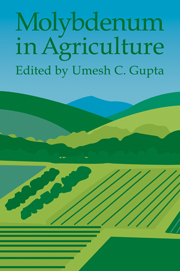Book contents
- Frontmatter
- Contents
- List of contributors
- Preface
- 1 Introduction
- 2 Chemistry and Mineralogy of Molybdenum in Soils
- 3 Distribution and Mobility of Molybdenum in the Terrestrial Environment
- 4 Biochemical Significance of Molybdenum in Crop Plants
- 5 Soil and Plant Factors Affecting Molybdenum Uptake by Plants
- 6 Analytical Techniques for Molybdenum Determination in Plants and Soils
- 7 Testing for Molybdenum Availability in Soils
- 8 Molybdenum Availability in Alkaline Soils
- 9 Deficient, Sufficient, and Toxic Concentrations of Molybdenum in Crops
- 10 Symptoms of Molybdenum Deficiency and Toxicity in Crops
- 11 Sources and Methods for Molybdenum Fertilization of Crops
- 12 Yield Responses to Molybdenum by Field and Horticultural Crops
- 13 Responses of Forage Legumes and Grasses to Molybdenum
- 14 Molybdenum and Sulfur Relationships in Plants
- 15 Molybdenum in the Tropics
- Index
15 - Molybdenum in the Tropics
Published online by Cambridge University Press: 10 December 2009
- Frontmatter
- Contents
- List of contributors
- Preface
- 1 Introduction
- 2 Chemistry and Mineralogy of Molybdenum in Soils
- 3 Distribution and Mobility of Molybdenum in the Terrestrial Environment
- 4 Biochemical Significance of Molybdenum in Crop Plants
- 5 Soil and Plant Factors Affecting Molybdenum Uptake by Plants
- 6 Analytical Techniques for Molybdenum Determination in Plants and Soils
- 7 Testing for Molybdenum Availability in Soils
- 8 Molybdenum Availability in Alkaline Soils
- 9 Deficient, Sufficient, and Toxic Concentrations of Molybdenum in Crops
- 10 Symptoms of Molybdenum Deficiency and Toxicity in Crops
- 11 Sources and Methods for Molybdenum Fertilization of Crops
- 12 Yield Responses to Molybdenum by Field and Horticultural Crops
- 13 Responses of Forage Legumes and Grasses to Molybdenum
- 14 Molybdenum and Sulfur Relationships in Plants
- 15 Molybdenum in the Tropics
- Index
Summary
Introduction
Molybdenum (Mo) is an essential plant nutrient. It acts as a metallic cofactor in plant and animal enzymes. At high concentrations in forages, it can be toxic to ruminants by interfering with assimilation of copper (Cu). The range between toxicity and deficiency in animals is narrow, and therefore careful control of Mo in animal diets is essential.
Bear (1956) reviewed the early literature dealing with Mo in soils and plants and in animal nutrition in a special issue of Soil Science. The agricultural importance of Mo has been discussed (Mortvedt, Giordano, and Lindsay, 1972), and various aspects of the presence of Mo in the environment have been examined (Chappell and Petersen, 1977). Underwood (1977) and Beeson and Matrone (1976) have reviewed the biochemical importance of Mo in animal and human nutrition.
Molybdenum deficiency in tropical and subtropical soils is more widespread than elsewhere because soils in the tropics are highly weathered. In fact, many soils in the tropics are so highly weathered that little remains except sesquioxides and some 1:1 layer silicates (Pasricha and Fox, 1993). The acidic nature of many of these soils with a dominant content of sesquioxides is the major cause of Mo deficiency.
- Type
- Chapter
- Information
- Molybdenum in Agriculture , pp. 245 - 270Publisher: Cambridge University PressPrint publication year: 1997
- 2
- Cited by



